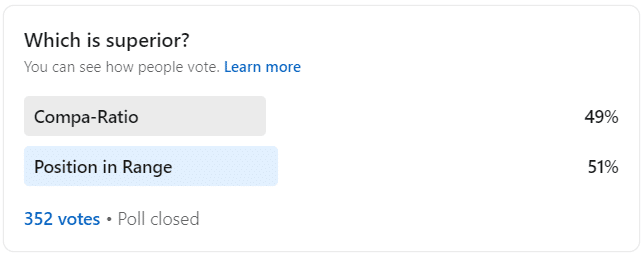Compa-Ratio vs Position in Range: How to Explain Both to Managers
The rapid growth of pay transparency has placed greater emphasis on managers being able to effectively communicate compensation and their Organization’s compensation philosophy to employees. In this article, we’ll dissect compa-ratio and position-in-range to determine which provides the better explanation of pay for the average worker.
Compa-Ratio: The Simplest form of Pay Evaluation
Compa-ratio is a fundamental tool determining an employee’s salary in relation to the midpoint of their pay band and is calculated by dividing the employee’s salary by the midpoint of their pay band.
Compa-Ratio = (Employee’s Salary / Midpoint Salary)
The formula for calculating Compa-ratio
This formula quickly reveals how closely an employee’s salary aligns with the midpoint of their pay band. Employees with a compa-ratio less than 1.0 are paid below their midpoint. For those that have a compa-ratio greater than 1.0, they are paid above their midpoint.
The formula is simple and easily understood. Yet, one cannot help but wonder, are there additional secrets to unveil? Might another formula shine more light on an employee’s pay?
Position-in-Range: An Emphasis on the Whole Range
Position-in-range is another method used to evaluate an employee’s salary within their pay band and has the advantage of providing deeper insight into the full salary range, compared to compa-ratio. However, for some, calculating the position-in-range is akin to deciphering an ancient formula, a process that requires precision and understanding.
While compa-ratio only requires the midpoint and the salary, calculating the position in range requires several crucial elements: (1) the employee’s pay, (2) the pay band minimum, and (3) the pay band maximum.
Position-in-Range = [(Employee’s Salary – Minimum) / (Maximum – Minimum)]
The formula for calculating position in range
Position-in-range is calculated by first subtracting the minimum of the pay band from the employee’s salary, and then dividing those results by the difference between the maximum and minimum of the same pay band. The results of this formula indicate the employee’s relative standing within the pay band, with higher percentages signifying a position closer to the maximum salary, ranging from 1 (the bottom of the range to 100, the top of the range).
Compa-Ratio vs. Position-in-Range: How to Choose
Compa-ratio, by focusing on the midpoint salary, provides a clear reference point for employees to grasp their standing in relation to the midpoint of the range. However, its reliance on the midpoint may not accurately reflect the intricacies of pay bands, especially in those with larger salary ranges.
Position-in-range, on the other hand, explores the full spectrum of the pay band by considering both the minimum and maximum and where the employee falls. Using position-in-range also allows Compensation and HR teams to quickly assess what quartile (or tertile or quintile) an employee falls within. Compa-ratio cannot provide this level of insight. However, though this method offers a more comprehensive analysis, its complexity may shroud its meaning in obscurity for some employees.
The Verdict
As any good consultant will tell you: “It depends.” In fact, the room is often times split. We asked more than 350 compensation practitioners which is superior, and there was not a clear winner.

However, for Organizations seeking to take their first step in providing more information about compensation to employees, compa-ratio emerges as the victor. Its simplicity and focus on the midpoint salary offer a more accessible point of reference for employees, enabling them to better grasp their pay and how it aligns with the midpoint.
Position in the range is more complicated to calculate, and the results can’t as easily be distilled down to “above” or “below” like compa-ratio. While it provides more detail about the whole range, the additional steps taken to calculate put PIR at a disadvantage, especially if this is your Organization’s first step into pay transparency and compensation communication.
If that is the case, then between these two contenders, the victor is compa-ratio.
Authors Note: Quartiles Provide An Alternative Approach
My preference has always been to use position-in-range, because of the additional context regarding the entire pay band. However, as noted in the article, many organizations choose compa-ratio due to its simplicity. Another option, however, is to use a quartile (or quintile) approach to explaining pay. Quartiles are easily explainable to employees, align with many companies’ merit matrices and compensation philosophies, and provide similar context to position in range.



2 Responses
I have always been a fan of position in range (PIR). The analogy that I draw often is that the gas gauge if you’re empty that means you have no gas ( 0 PIR)if that if your full means you’re 100% full (PIR 100). With that is an explanation people tend to get the whole position in range concept. Agreed calculation of the can be a disadvantage, however, it gives employees and managers a better picture as to where they are in the range. You and I could have the same Compa ratio and I could be below the middle minimum and you could be above the minimum if we had different range widths. Another thing that PIR does is allows us to take the focus off of the midpoint. I believe there is too much focus on midpoint, and if an employee is pay below the midpoint, they feel as though they are underpaid relative to the market, when that may not be the case, given their level of performance.
100% agree with your comment Mark. I too prefer PIR, especially with that fact that not everyone has to be paid at the midpoint.